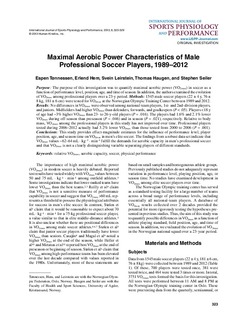| dc.contributor.author | Tønnessen, Espen | |
| dc.contributor.author | Hem, Erlend | |
| dc.contributor.author | Leirstein, Svein | |
| dc.contributor.author | Haugen, Thomas | |
| dc.contributor.author | Seiler, Stephen | |
| dc.date.accessioned | 2013-07-17T13:42:37Z | |
| dc.date.available | 2013-07-17T13:42:37Z | |
| dc.date.issued | 2013 | |
| dc.identifier.citation | Tonnessen, E., Hem, E., Leirstein, S., Haugen, T., & Seiler, S. (2013). Maximal aerobic power characteristics of male professional soccer players, 1989-2012. International Journal of Sports Physiology and Performance, 8(3), 323-329. | no_NO |
| dc.identifier.issn | 1555-0265 | |
| dc.identifier.uri | http://hdl.handle.net/11250/139061 | |
| dc.description | Published version of an article in the journal:International Journal of Sports Physiology and Performance. Also available from Human Kinetics: http://journals.humankinetics.com/ijspp-back-issues/ijspp-volume-8-issue-3-may/maximal-aerobic-power-characteristics-of-male-professional-soccer-players-1989ndash2012 | no_NO |
| dc.description.abstract | Purpose: The purpose of this investigation was to quantify maximal aerobic power (VO2max) in soccer as a function of performance level, position, age, and time of season. In addition, the authors examined the evolution Of VO2max among professional players over a 23-y period. Methods: 1545 male soccer players (22 +/- 4 y, 76 +/- 8 kg, 181 +/- 6 cm) were tested for VO2max at the Norwegian Olympic Training Center between 1989 and 2012. Results: No differences in VO2max were observed among national-team players, 1st- and 2nd-division players, and juniors. Midfielders had higher VO2max than defenders; forwards, and goalkeepers (P < .05). Players <18 y of age had similar to 3% higher VO2max than 23- to 26-y-old players (P = .016). The players had 1.6% and 2.1% lower VO2max during off-season than preseason (P = .046) and in season (P = .021), respectively. Relative to body mass, VO2max among the professional players in this study has not improved over time. Professional players tested during 2006-2012 actually had 3.2% lower VO2max than those tested from 2000 to 2006 (P = .001). Conclusions: This study provides effect-magnitude estimates for the influence of performance level, player position, age, and season time on VO2max in men's elite soccer. The findings from a robust data set indicate that VO2max values similar to 62-64 mL . kg(-1) . min(-1) fulfill the demands for aerobic capacity in men's professional soccer and that VO2max is not a clearly distinguishing variable separating players of different standards. | no_NO |
| dc.language.iso | eng | no_NO |
| dc.publisher | Human Kinetics | no_NO |
| dc.title | Maximal aerobic power characteristics of male professional soccer players, 1989-2012 | no_NO |
| dc.type | Journal article | no_NO |
| dc.type | Peer reviewed | no_NO |
| dc.subject.nsi | VDP::Medical disciplines: 700::Sports medicine: 850 | no_NO |
| dc.source.pagenumber | 323-329 | no_NO |
| dc.source.volume | 8 | no_NO |
| dc.source.issue | 3 | no_NO |
